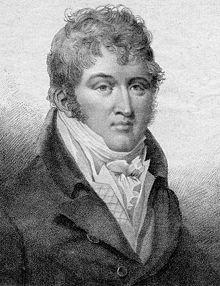Richard Chenevix (chemist)

Richard Chenevix FRS (ca. 1774 – 5 April 1830) was an Irish chemist.
Chenevix was a chemist who played a role in the discovery of the elemental nature of the metal palladium. Disbelieving this solid to be an element, in 1803 he published his opinions that it was a combination of mercury and platinum. This had, somewhat indirectly, the effect of spurring on others to examine the new metal, which is indeed an element.
Chenevix was elected a Fellow of the Royal Society in 1801 and was awarded its Copley Medal in 1803. He married the Contesse de Rouault on 4 June 1812 at Marylebone Church.
Richard Chenevix died in Paris in 1830 and was buried at Père Lachaise Cemetery.
The mineral Chenevixite was named in his honor because of his earlier work analyzing copper ferrate arsenates.[1]
References
- ^ Chenevixite: Chenevixite mineral information and data, mindat.org, retrieved February 2, 2010.
Further reading
- Reilly, Desmond (1955). "Richard Chenevix (1774-1830) and the Discovery of Palladium". Journal of Chemical Education. 32: 37–39. doi:10.1021/ed032p37.
- Usselman, Melvyn C. (1978). "The Wollaston/Chenevix Controversy over the Elemental Nature of Palladium: A Curious Episode in the History of Chemistry". Annals of Science. 35 (6): 551–579. doi:10.1080/00033797800200431.
External links
- Griffith, W. P. (2003). "Part I. Rhodium and Palladium - Events Surrounding their Discoveries". Platinum Metals Review. 47 (4): 175–183.
- Chenevix, Richard (1812). Two Plays. London: J. Johnson & Company.
- Chenevix, Richard (1832). An Essay Upon National Character. London: James Duncan.
